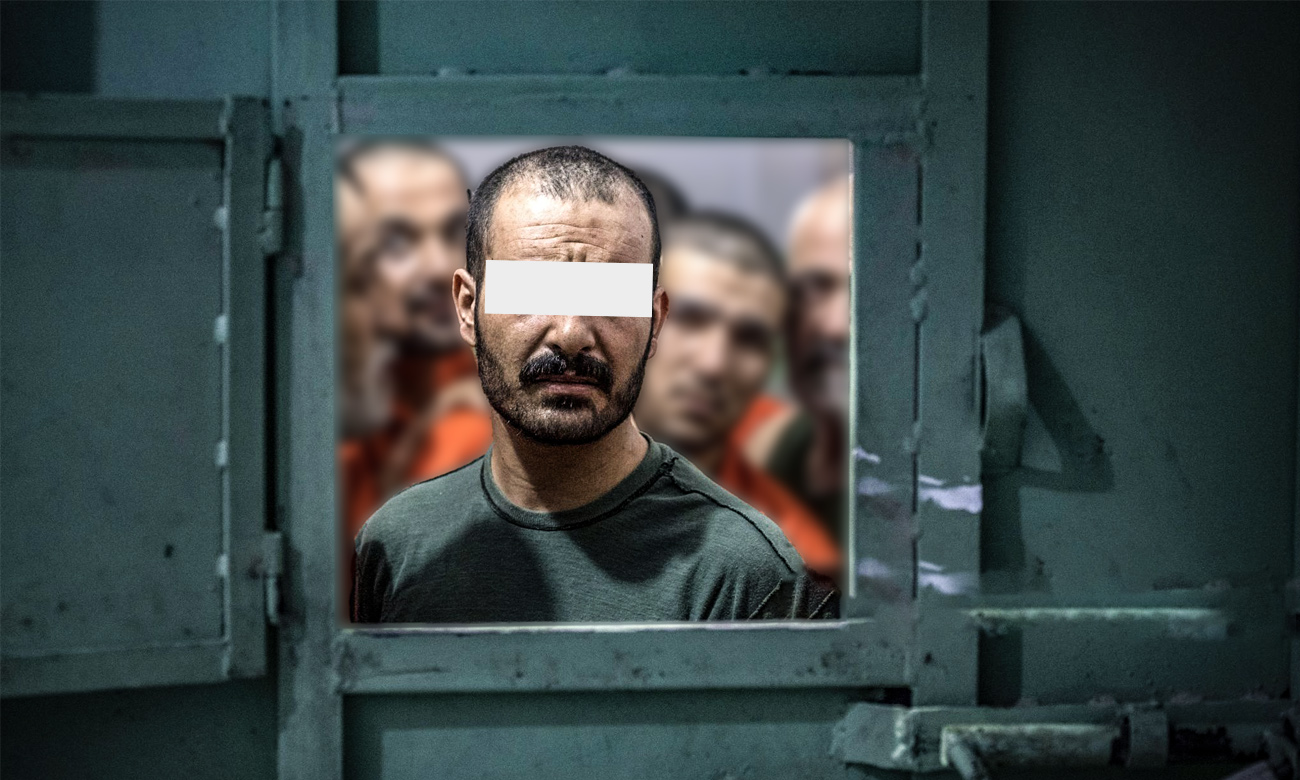
Here to stay: Islamic State revives attacks amid futile counter campaigns in Syria

Hussam al-Mahmoud | Amal Rantisi | Khaled al-Jeratli | Hassan Ibrahim
After the beginning of the Syrian revolution in 2011, the Islamic State (IS) group expanded its activity to include Syria to “support the Syrian people,” according to IS’ claims presented in a propaganda documentary entitled “The End and the Beginning,” released in January 2021.
However, IS’ presence declined and its influence shrunk in Syria following the intervention of the US-led International Coalition Forces (ICF) in 2015, which launched extensive battles against IS in Syria and Iraq.
As a result, the military group, which emerged from the remnants of the al-Qaeda in Iraq, moved from a clear and open fighting strategy to conducting operations in scattered geographical pockets, with the Syrian Desert as the main stage for its operations and the knot that kept unloosened despite years-long military action and security campaigns by different armed parties in Syria.
On 19 January, IS carried out a massive operation to free its arrested leaders and members from Ghweran prison in al-Hasakah, which is under the full control of the Kurdish People’s Protection Units (YPG) and the ICF’s protection.
In this in-depth article, Enab Baladi discusses with experts and researchers the recent increase in IS’ systematic attacks, as opposed to failed military efforts to curb its activities and limit its risks. Enab Baladi also highlights the importance of the Syrian Desert to IS and the current military action undertaken to eliminate the Islamic State.
The Syrian Desert: A stage for IS’ operations in Syria
Although IS does not specify the locations of its 2,748 attacks worldwide, which were mostly carried out with explosive devices, booby-trapped vehicles, and mines, Syria ranked third in the number of IS attacks with 368 targetings that resulted in 736 deaths, according to statistics published by the Telegram channel of Amaq Agency, IS-run news outlet, on 9 January.
The statistics included IS attacks in different spheres of influence across Syrian geography without specifying their geographical distribution.
After IS’ control diminished in Syria, the militant group adopted guerrilla tactics. It carried out hit-and-run operations, benefiting from the geography and terrains of the Syrian Desert, where IS sleeper cells would target regime forces’ convoys and the Syrian Democratic Forces (SDF).
IS fighters and sleeper cells’ movements in the Syrian Desert are undetected, as militants appear on scene only to carry out attacks and disappear again in the desert.
The Syrian Desert covers the areas from the eastern countryside of Hama and Homs governorates to the Iraqi borders and from the countryside of Deir Ezzor and Raqqa in northern Syria to the Syrian-Jordanian borders.
It covers a total area of over 75,000 square kilometers out of Syria’s land area of about 185,000 square kilometers.
The early weeks of 2022 witnessed several operations by IS in the Syrian Desert area; the latest was on 6 January and led to the killing of three regime’s elements and the wounding of four others in two separate attacks in the Raqqa countryside.
IS did not claim responsibility for the operation against the regime forces, but many local news networks indicated back then that IS cells carried out the targeting.
Three days earlier, IS attacked a group of regime soldiers in the Homs Desert in eastern Syria and killed five of them.
The state-run Syrian Arab News Agency (SANA) cited a military source it did not name that a military bus was targeted by an IS’ rocket attack, 50 kilometers to the east of the T3 oil pump station, noting that the attack killed five military personnel and injured 20 others to various degrees.
Homs and Deir Ezzor governorates are among the areas to witness the most centered presence for Iran-affiliated militias in Syria, a study by the Jusoor Center for Studies mentioned, noting that Deir Ezzor alone contains 64 military sites and 512 posts, controlled mainly by Iran.
Assassinations loom over Deir Ezzor
In early 2021, IS increased its attacks in Deir Ezzor governorate, starting with the targeting of Hussein Sheikh al-Jamil, one of the dignitaries of the al-Bakir clan in the al-Izba area to the north of Deir Ezzor.
Al-Bakir is one of the clans of the al-Akidat tribe, which had some of its dignitaries targeted in early 2021; the latest was Sheikh Atlyush al-Shitat al-Lafi, who was killed on 12 January 2021.
Commander in SDF’s First Regiment, Suleiman al-Abboud al-Latto (aka the Scorpion), was killed in the countryside of Deir Ezzor in mid-June 2021.
In a statement published by IS-affiliated Amaq Agency in May 2021, IS claimed responsibility for the targeting and shooting of a member of the Autonomous Administration of North and East Syria (AANES)’s religious institution in the village of al-Geneina, leading to his killing by gunshots.
Moreover, ten workers of al-Kharata oil field in the southwestern countryside of Deir Ezzor were killed on 2 December 2021, according to SANA.
SANA reported a “terrorist attack” against a bus carrying workers returning from the al-Kharata oil field, leading to the death of ten of them and the injury of another worker.
On 3 December 2021, two elements of the regime forces were killed by an IS attack on the regime’s military sites in the desert of Deir Ezzor.
The National Defense Forces (NDF), a pro-regime militia in Deir Ezzor, confirmed on its Facebook account on 2 December 2021 the killing of two of its elements by an IS attack in the desert of al-Masarab in the western countryside of Deir Ezzor.
On 12 December 2021, IS took responsibility for the killing of SDF leader Adham Dibish al-Abes (aka Abu Abdullah al-Jarthi) and one of his companions in Thiban town, east of Deir Ezzor.
On the same day, IS acknowledged the abduction and killing of an SDF element in Hajin town in the eastern countryside of Deir Ezzor. However, the identity of this person remains unknown till the writing time of this article.
Deir Ezzor: “A scale model for the Syrian conflict”
A study by the Harmoon Center for Contemporary Studies mentioned that Syria’s eastern region, particularly Deir Ezzor governorate, constitutes a scale model for the ongoing Syrian conflict.
The governorate of Deir Ezzor is home to all conflicting forces in Syria, namely the United States, Russian and Iranian forces, and other local forces, including Syrian regime-affiliated militias, such as the NDF, in addition to Iraqi, Iranian, Afghan, and Pakistani militias.
The governorate also has tribal forces linked to the parties in control on both sides of the Euphrates River, in addition to the SDF and its associated militias.
According to the study, the Turkish and Saudi influences are also present in Deir Ezzor governorate, which serves as a stage for the fighting between the conflict parties in an area of no more than 33,000 square kilometers, the approximate area of the province including its desert.
The Syrian regime is the “weaker party” in the competition over control among the conflict parties in Deir Ezzor. Still, the regime and its militias are active players in the Iranian-Russian influence competition.

IS fighters waving flags during a military parade along the streets of Raqqa governorate in northern Syria – 30 June 2014 (Reuters)
IS’ comeback strategy
IS has intensified its operations in the Syrian Desert since the beginning of 2021. It continues to carry out attacks and ambushes while hiding in the desert’s pockets, despite successive campaigns by the Russian-backed Syrian regime forces and AANES’s military wing and the ICF’s partners, the SDF.
Even though IS has claimed responsibility for many targeting operations through Telegram, some operations’ perpetrators remain unknown, particularly in the desert area between Homs and Raqqa governorates and the desert of Deir Ezzor in eastern Syria.
In its operations, IS relied on sporadic attacks against military points or military columns traveling along the desert by engaging in armed clashes or using explosive devices.
Abbas Sharifa, a researcher in jihadist groups affairs, told Enab Baladi that IS still relies on ambushes, raids, and guerrilla warfare tactics. It limits its operations to international roads and the desert region and depends on small groups of fighters capable of moving fast and lightly to bring its strategy to success.
Sharifa pointed out that IS is not seeking direct control on land and sees its interest in hit-and-run operations as an act of defiance and attrition against its enemies.
IS shifts attacks from the Syrian Desert to SDF areas
IS’ operational activity witnessed a different turn in the attack on Ghweran prison, one of the biggest prisons to include arrested IS fighters and leaders in al-Hasakah governorate.
On the evening of 19 January, IS fighters infiltrated into the prison’s perimeter and engaged in clashes in an attempt to liberate their comrades after detonating car bombs at the prison’s main gate.
Confrontations developed as dozens of prisoners managed to escape and join IS cells stationed in the neighborhoods surrounding the prison’s perimeter, such as the al-Zuhour and al-Maqaber neighborhoods.
Ghweran prison is under the full control of the US and internationally supported SDF and is located in the outskirts of Ghweran neighborhood at the southern entrance of al-Hasakah city.
The SDF holds thousands of IS fighters as prisoners, including nearly 4,000 foreigners from around 50 countries.
On 21 January, Amaq Agency cited a security source saying that IS fighters had been carrying out a large-scale offensive on the prison since 20 January to “free prisoners held inside,” and that clashes were ongoing near the prison and in other neighborhoods.
However, SDF commander, General Mazloum Abdi, announced on 21 January the “success” of SDF security forces backed by the ICF in arresting all escaped prisoners.
Meanwhile, local sources confirmed the continuation of clashes after 21 January.
Factors contributing to IS’ resurgence
The recent operations by IS have raised questions about the reasons for its resurgence despite being fought by the ICF, the regime, Russia, and the SDF.
Several parties are contributing to the re-emergence of IS in different ways. The SDF, for example, has been releasing its detained IS militants and throwing them into desert battles.
The SDF, which oversees prisons in northeast Syria, is accused of releasing IS prisoners in exchange for “settlement” money, but the SDF denies these accusations.
The SDF announces on a recurrent basis the release of IS militants who were not involved in harming Syrians under tribal meditation.
A study by the US-based Middle East Institute, published on 5 May 2021, said that the resurgence of IS can be attributed to the wrongheaded policies of the AANES, including the release of IS fighters, failure to manage economic issues, and the failure of governance systems and the administration in dealing with tribal communities.
According to Sharifa, the potential comeback of IS would help the Syrian regime exert more pressure on the As-Suwayda governorate, which came under an IS attack in July 2018 that caused over 200 deaths among civilians and local fighters, according to estimates mentioned in a UN report on 31 July 2018.
The severe attack enraged locals in As-Suwayda, who accused the regime of facilitating the IS’ attack on the city due to their refusal to enlist in its army.
The cessation or lack of international security operations against IS indicates its potential resurgence or restoration of control over some regions, Sharifa said, excluding the possibility of IS comeback in the foreseeable future.
The ICF supports the SDF in its operations against IS; however, the pace of these operations was reduced compared to previous years.
IS’ funding sources
Military structures that operate independently from states and governments rely on various funding sources to ensure their sustainability, including internal funds, donations from political parties linked to particular countries, and battle gains.
According to Sharifa, IS has the ability to re-mobilize and recruit a large number of fighters amid the absence of a political solution and instability in Syria and Iraq, and even though IS suffered massive losses on battlefields, the group did not suffer a significant loss in combatants and human resources.
IS managed to launch new attacks relying on funds and resources it collected when it was in control in the eastern region, Sharifa added.
Prior to its defeat announcement in 2018, IS controlled many oil fields and wells in eastern Syria, each producing tens of thousands of barrels daily, sold exclusively in the US dollar.
Despite extensive media reports on IS operations and attacks in the Syrian Desert, the group failed to impose its control on the ground and refrained from using vehicles or car bombs in a way similar to what it did when it first emerged in the region.
This change in strategy can be interpreted as an effort to reduce human and financial losses through targeting mobile forces or fixed military bases and points with sporadic attacks and explosive devices.
IS’ latest operations are aimed at seizing financial resources and armaments as part of a self-financing and arming strategy, rather than to establish its control on the military scene, Sharifa said.
The targeting of military points is helping IS obtain weapons, Sharifa said, adding that IS also benefits from external funding, which is limited in light of security crackdowns against it.

IS fighters waving flags during a military parade along the streets of Raqqa governorate in northern Syria – 30 June 2014 (Reuters)
A Russian investment
Russia’s military campaign against IS started in 2015 when it carried out its first airstrikes against the group in support of the Syrian regime.
A 2021 report entitled “6 Year on: Russia’s Intervention in Syria” by the Jusoor Center for Studies mentioned that the main task under which Russia intervened in Syria was to “fight terrorism,” and for that, it focused its combat operations against IS, after ensuring the disruption of the abilities of the Syrian opposition to launch effective and highly effective attacks by besieging it and cutting off the main supply routes the factions used to use.
Russia mobilized its forces alongside the regime forces represented in the Fifth Corps and the Palestinian militia of al-Quds Brigade and intensified its aerial bombardment and ground military operations against IS cells, most recently in the Syrian Desert.
In late August 2020, Russia launched Operation White Desert to pursue IS cells in the Syrian Desert area between al-Bukamal city on the Syrian-Iraqi borders and al-Mayadin city to the southeast of Deir Ezzor and al-Sukhnah to the east of Homs.
Another research paper by the Jusoor Center for Studies entitled “The Launch of the Third Stage of Operation White Desert” said that the Fifth Corps and al-Quds Brigade participated in the military campaign against IS, led directly by Russian army officers, alongside two Russian formations. The first formation included 75 fighters subordinate to the Russian Special Forces, while the second was composed of 120 fighters subordinate to the Wagner auxiliary forces.
Operation White Desert was launched after IS assassinated Russian General Vyacheslav Gladkikh on 18 August 2020 and then attacked a vehicle garage for Russian forces in the Syrian Desert, the paper added.
Russian concerns
On 21 December 2021, the Russian President’s Special Envoy to Syria, Alexander Lavrentiev, expressed Russian concerns about the increased activity of what he called “terrorist organizations in Syria,” including the Islamic State. He also voiced Russia’s concerns regarding IS’ increased aggression and “provocative actions” against the Syrian regime forces.
During a press conference after the seventh round of the Astana talks on 22 January 2021, Lavrentiev referred to IS’ increased aggression by saying, “With our generally positive assessment of the evolution of the situation in Syria in terms of stability, we have drawn attention to the fact that the latest months have witnessed an escalation in terrorist attacks, particularly by IS sleeper cells.”
Lavrentiev continued, “In recent months, IS’ activity has escalated to an unacceptable extent, as representatives of security bodies and legitimate authorities, as well as former fighters who settled their status, have been subjected to terrorist operations on an almost daily basis.”
The Russian recognition of IS’ increased aggression towards the regime forces and its affiliated militias did not prevent Russia from promoting its efforts in combating IS, despite the lack of satisfactory results on the ground.
Russian Deputy Foreign Minister, Oleg Syromolotov, told Sputnik news agency on 29 December 2021 that the year-long cooperation between Russian and regime forces had enhanced success chances in combating IS.
“We view positively the fact that, in 2021, the Russian Armed Forces, in close cooperation with the Syrian Armed Forces, continued to consolidate their successes in confronting the activities of the Islamic State in the territories of Syria. As a result, the capabilities of this organization have been significantly weakened, its power and important means eliminated, the organizational structure destroyed, and resources reduced.”
“Russia has tried to demonstrate its ability to be a reliable partner in the war against terrorism and to provide an encouraging model for confronting threats from jihadist organizations such as IS, in contrast to the model of the US-led International Coalition,” according to Jusoor Center’s analytical report on the most prominent stages of Russian intervention in Syria in six years.
Although Moscow claims its intervention in Syria was to eliminate terrorism, it has consistently attacked the US-led International Coalition’s campaign against IS. It views international efforts to defeat IS as a violation of Syria’s sovereignty and questions the objectives of the international coalition and the legitimacy of its strikes against IS in Syria, despite its approval of United Nations Security Council Resolution 2170 on countering terrorism.
The Russian failure in the Syrian Desert
IS faces difficulty in obtaining primary resources necessary for its operations in Syria, and this prompted it to rely on explosive devices and sporadic aggression, an analytical report on IS activity in Syria and Iraq during 2021 by Jusoor Center for Studies in cooperation with Informagene blog for data analysis on 13 January mentioned.
In Syria, most attacks with improvised explosive devices (IED) targeted government forces and pro-government militias, particularly along supply lines between the capital, Damascus, and the front lines in the Syrian Desert. In addition, most of these attacks targeted buses transporting soldiers and fighters for pro-regime militias.
Russia and Iran have engaged their militias or formal military formations in several operations against IS cells in the Syrian Desert since IS’ expulsion from its last stronghold of al-Baghouz town on 23 March 2019.
Russian media reported several operations against IS cells in 2021 and talked about their tactics, with Russia relying on reconnaissance-based airstrikes and land sweepings in its latest military operations against IS.
Russian warplanes carried out up to 100 airstrikes in one day alone during the White Desert Operation and destroyed hideouts which IS used as storage facilities for weapons, equipment, and food.
In September 2021, Russian war correspondent who accompanies Russian forces in Syria, Oleg Blokhin, posted a video recording showing the Russian Air Force carrying out airstrikes on IS bases in the Syrian Desert in response to attacks on regime’s convoys and military patrols there.
In June 2021, the Russian Topwar website reported that the Russian-Syrian air forces had launched airstrikes on IS sites to the east of Hama governorate, destroying its communications sections and a weapons and ammunition warehouse. However, the same website said that the regime forces and its militias’ operation ended in failure because the “terrorists” attacked a convoy of Syrian troops near Athriya area, eastern Hama, destroying a vehicle and killing a soldier while other four soldiers were injured.
Russia’s failure in the Syrian Desert operations is evidenced by IS’ continued targeting of the regime and Russian forces there.
The report by Jusoor Center and Informagene added that it is too early to say that IS has lost its ability to carry out various types of operations while it continues to move freely and carry out operations in open areas such as the Syrian Desert or supply lines.

IS fighters waving flags during a military parade along the streets of Raqqa governorate in northern Syria – 30 June 2014 (Reuters)
The Syrian Desert complicates IS’ elimination plans
Nawar Shaaban, a researcher, and chief information officer at Omran Center for Strategic Studies, pointed out the difficulty of military operations in the Syrian Desert, as they require high logistical and military costs, owing to the desert’s geographical nature, making it more difficult to control the region.
According to Shaaban, since 2017, Russian operations in the Syrian Desert have remained confined to certain areas, including south of Raqqa, northeastern Homs, or rural Deir Ezzor.
The Russians target a particular area in their airstrikes, making it easy for IS cells in the targeted area to escape to another safe area, Shaaban said.
The director of Informagene data analysis blog, Obada Ahmad al-Abdullah, who oversaw the analytical report on IS’ activity in Syria and Iraq during 2021, told Enab Baladi that the failure of the Russian-Syrian joint operations in the Syrian Desert is due to several reasons, mainly the regime forces’ inability to cover large and open areas within the Syrian Desert, despite intelligence support and the occasional air coverage provided by Russian warplanes to forces on the ground.
Another reason is that the fighting and mobility tactic adopted by IS is in line with the latest developments and various changes affecting its enemies, al-Abdullah added.
In addition, IS benefits from the conflict and lack of effective coordination between the parties within its geographical presence. The lack of coordination and understanding between the Russian and Iranian forces, the SDF, and the international coalition, together with the regime forces, allows IS to move easily between these parties’ areas.
According to al-Abdullah, it is unlikely that the Russian-Syrian joint operations against IS have achieved any positive results given the figures and data collected and IS’ ability to effectively target and inflict significant losses against Syrian regime forces and affiliated militias.
The number of human losses among Syrian regime forces increased by 18.8 to 21.2 percent compared to the numbers between 2020 and 2021. At the same time, the number of IS operations against regime forces did not drop during the same period.
Based on these statistics, the joint operations between the Syrian regime and the Russian forces have failed in achieving a positive outcome. Likewise, military operations between other parties will also fail to end IS’ presence in the region, al-Abdullah said, adding that it is unlikely for the world to witness joint efforts between key players in Syria against IS due to substantive divergences among them.
Futile military efforts
In addition to Russian, Iranian, and international coalition operations, the SDF has conducted security operations against IS separately and in cooperation with coalition forces.
The SDF has led recent solo and joint security operations against IS, in which it dismantled 93 “terrorist cells” and foiled 16 “dangerous terrorist schemes,” according to a statement released by the SDF on 3 January addressing its operations against IS during 2021.
According to the statement, the SDF launched a sweeping campaign alongside the Internal Security Forces in March 2021 to track down “terrorist cells” in al-Hawl camp, arresting “dozens of elements and foiling many potential operations in the camp.”
It also arrested 802 members of IS cells, suspects, and others accused of assisting its militants in 2021.
The SDF’s security operations left eight deaths among IS cells, along with 47 operations canceled by the SDF’s security forces “in their final stages,” according to the same statement.
The SDF dismantled 87 explosive devices and thwarted 16 attack attempts against al-Hasakah prison run by the SDF.
The SDF statement also mentioned attempts by IS leaders and elements to reorganize their ranks and take advantage of security conditions created by the SDF’s preoccupation with attacks by the Turkish-backed Syrian National Army (SNA), which the SDF described as simultaneous attacks.
SDF positions continue to witness attacks by IS to this day but in varying intensity and frequency.
The many military operations and security campaigns against IS by different players in Syria do not change the reality that these operations had little impact on IS, which continues to launch attacks in a free and effective manner, benefiting from the Syrian Desert’s geography that serves as a labyrinth for military clashes rather than a battlefield.
In response to a question about the effectiveness of security operations against IS and the re-launching of new ones under new names, Shaaban said that mere talking about a new military operation means that previous operations have not achieved what is required of them.
The SDF’s operations against IS were a failure, as some areas in Deir Ezzor and Raqqa continue to witness tensions between the SDF and the locals, which IS exploits for its benefit.
As for IS’ fate and the possibility of eliminating it by military and security operations, Shaaban explained that the elimination of IS as a transborder force with objectives and control areas has already taken place, but the eradication of IS with its current strategy is unlikely to happen, despite repeated operations by various parties.
Shaaban noted that although IS’ chances of establishing sovereignty or authority over a region have declined, it has the dark side of actual countries, reflected in illegal businesses, such as smuggling operations and so on.
What is the International Coalition’s position?
Enab Baladi contacted the International Coalition by email to clarify its strategy against IS and the future of its military operation against IS cells; however, it received no response until the preparation time of this article.
A statement by the media office of the Presidency of the Kurdistan Regional Government, of which Rudaw media network said it had received a copy, mentioned that the Deputy Commander General of Coalition Forces in Iraq and Syria, Karl Harris, confirmed the support of Coalition forces to the Kurdish Peshmerga forces against “IS terrorists” during a meeting with the Prime Minister of the Kurdistan Regional Government, Masrour Barzani, on 18 January.
Harris reiterated that IS continues to pose a real threat to the security and stability of Iraq and Syria.
Meanwhile, Barzani stressed the need to strengthen communication mechanisms between the Iraqi army and Peshmerga forces to eliminate the threat of “IS terrorists” by activating joint security focal points between the two sides in Kurdish areas outside Kurdistan Regional Government’s administration.
The US Defense Department (Pentagon) confirmed that US airstrikes were carried out to support the SDF in its response to an escape attempt by IS fighters from the Ghweran prison in al-Hasakah.
“We have provided some airstrikes to support the SDF as they deal with this particular prison break,” Pentagon spokesman John Kirby stated.

IS fighters waving flags during a military parade along the streets of Raqqa governorate in northern Syria – 30 June 2014 (Reuters)
if you think the article contain wrong information or you have additional details Send Correction
النسخة العربية من المقال
-
Follow us :

















 A
A
A
A
A
A
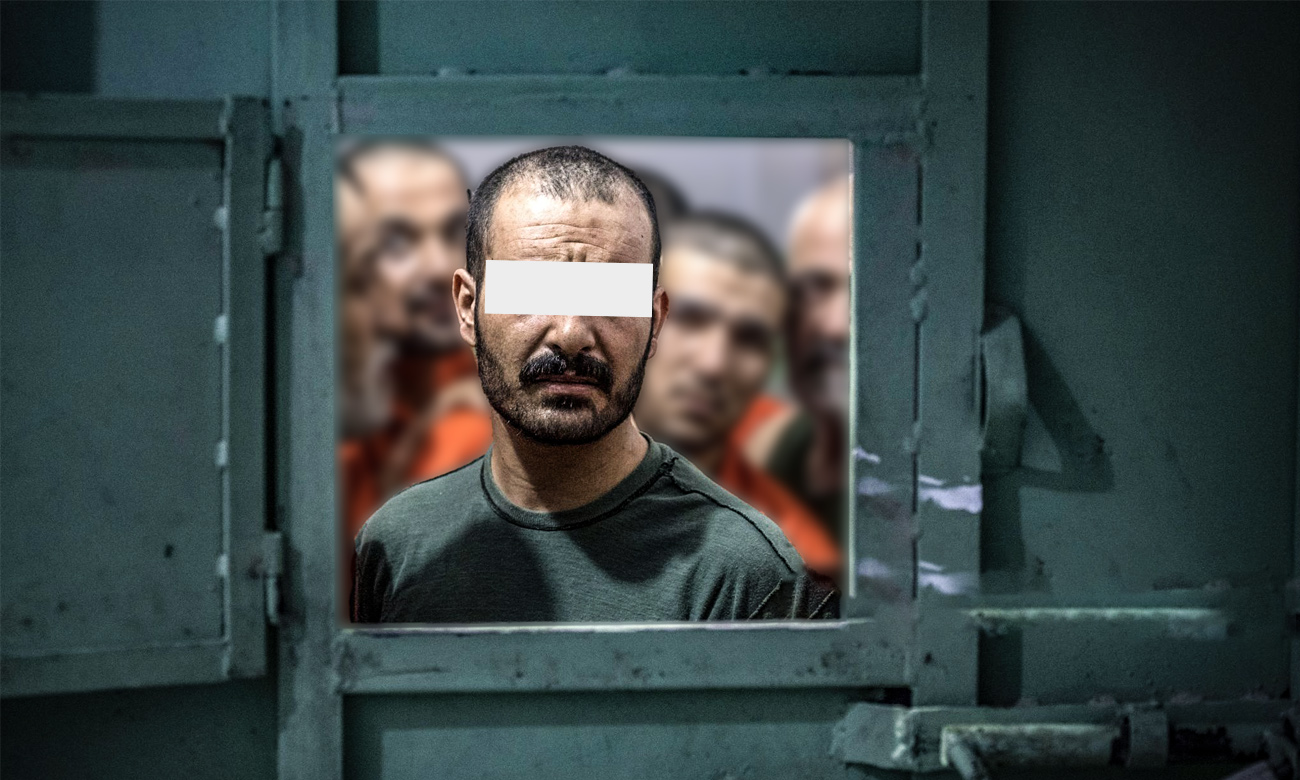



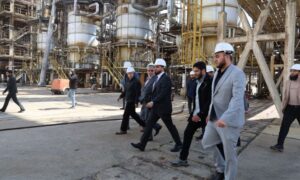


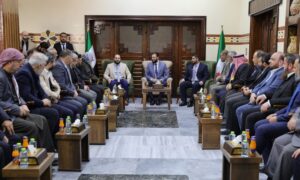
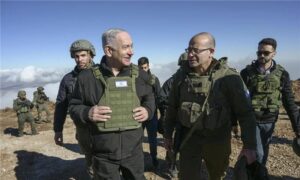
 More Investigations
More Investigations